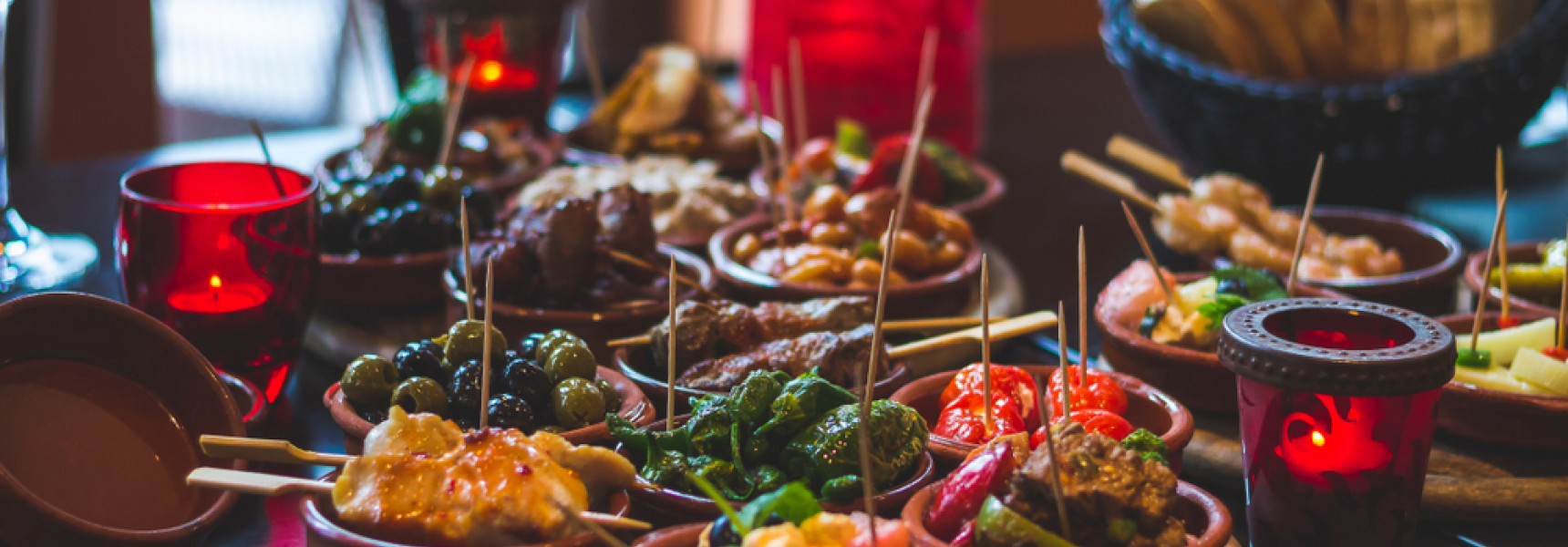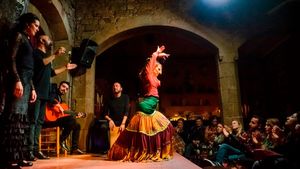Food Experiences
Barcelona
Published: 14 Jun 2022
Legend has it that tapas was traditionally served in Spanish taverns to help patrons keep the flies out of their drinks. Beverages would be served along with a small plate of bread or ham, which customers would place on top of their glass to keep insects at bay. These days, tapas is an integral part of Spanish culture and these small bar snacks offer the perfect way to sample an array of Spanish flavours within one meal.

What are the most popular types of Spanish tapas?
Tapas bars are evolving all the time to create more sophisticated dishes and put new spins on traditional flavour profiles, but we'll never grow tired of these classic tapas.
Olives
You can't go wrong with a portion of olives to accompany a few drinks. In tapas bars, the olives are usually pickled and stuffed with anchovies or peppers to deliver a salty, tangy flavour.
Croquetas
Bite-sized portions of creamy mashed potato are rolled in breadcrumbs and deep-fried to create croquetas. The mash can be combined with a whole array of other ingredients, with the most popular being ham, cheese, and fish.
Padrón Peppers
Originating from Galicia in northern Spain, these little green peppers are mostly mild and sweet, but every now and again, you'll find a spicy one that packs a punch. Traditionally, they are fried in olive oil and sprinkled liberally with sea salt.
Tortilla de patatas
The classic Spanish omelette is served in small wedges or squares for easy nibbling along with a drink. In its simplest form, tortillas are made with egg and potatoes, but some bars add ham, cheese and other ingredients for variety.

Albondigas
These meatballs are often made with a combination of pork and beef and are cooked in a tomato-based sauce with plenty of garlic and smoked paprika. They're a tapas classic and tend to have crusty bread on the side for dipping.
Carrillada
The cheeks of pork or beef are cooked low and slow, often in a whisky sauce, to produce a decadent melt-in-the-mouth dish. You'll want bread or fries on the side to soak up every morsel of sauce.
Chorizo
Flavourful chorizo is a type of cured, spicy sausage known for its vibrant orange-red colour. It's an incredibly popular tapas ingredient that might also be served as a dish in its own right. Be sure to try chorizo al vino, which has the sausage sliced and braised in red wine to bring out its deep, smoky flavour.
Patatas Bravas
These little cubes of fried potatoes are crispy on the outside and fluffy in the middle. They are usually served with a spicy tomato sauce, but you might also find them with cool garlic aioli.
Jamón Ibérico
This delicious ham is from Iberian pigs, which are fed on acorns, chestnuts and olives for a rich flavour. The ham is cured for at least twelve months before being thinly sliced into smooth, moreish slivers that are served alone or with bread and cheese.

Boquerones
Boquerones are anchovies, and you'll find them prepared in a couple of popular ways in tapas bars. The first is 'frito' meaning fried, which makes them wonderfully crispy and crunchy. The second is 'en vinagre', which means they are cured in olive oil, garlic and vinegar for a fresh and zingy mouthful.
Manchego
Tapas bars often have a variety of Spanish cheese available, but the most popular is Manchego. Made from sheep's milk, it is sweet, buttery and creamy, and lends itself to both sweet and savoury accompaniments. Traditionally, it is eaten with a sweet marmalade spread, but it also pairs well with honey and almonds.
What are the 3 types of tapas?
All tapas are small dishes of food or snacks, but there are three key varieties you'll come across.
Cosas de picar (finger foods)
These are foods that you can nibble on while sipping wine or beer. Olives, croquetas and Padrón peppers are the perfect examples.
Pintxos (skewers)
These are mouthfuls of food combining multiple ingredients skewered together with toothpicks, often with bread. Gilda is a good example of this; it is a simple but delicious skewer of olive, anchovy and hot pepper.
Cazuelas (little dishes)
These are foods which are served in dishes along with a sauce. Albondigas, carrillada and patatas bravas would all be defined as cazuelas.

What's the difference between tapas and pintxos?
Sometimes tapas and pintxos are used interchangeably, but there are subtle differences between the two. Tapas are small plates usually shared among a table, and pintxos are served on small pieces of bread and eaten individually.
Pintxos, also often call 'pinchos', originate from the Basque region of northern Spain. San Sebastian, one of the most popular tourists hotspots in Basque Country, has a wealth of bars serving traditional pintxos. A great way to experience pintxos is to try food and drink experiences in San Sebastian, which include a tour of the local area with pintxo tasting along the way.
The word 'pintxo' is derived from the Spanish verb 'pinchar', which means 'to pierce', and this refers to the way that a topping is secured to bread via a cocktail stick to create a snack that can be eaten by hand in one or two bites. You'll find lots of classic Spanish ingredients and flavour combinations in pintxos that you'd typically find in tapas, such jamón, croquetas, Padrón peppers, tortillas and anchovies, but they will be served in neat, skewered mouthfuls.
How many tapas should you order?
Tapas gives you a brilliant opportunity to try lots of small portions of different dishes, but it is easy to overdo it when there are so many exciting flavour combinations to sample. Usually, three tapas dishes per person is about right. Obviously, this means that the bigger your group, the more variety of tapas you can try.
Food and Drink Experiences in Spain
If you're travelling alone or in a couple, you might benefit from taking a private food tour that focuses on traditional taverns. These tours allow you to soak in the authentic atmosphere of Spanish bars, while sampling some of the most popular tapas dishes, along with a glass of fine wine in hand.
For more information about Spain's food and drink experiences, take a look at tabl.com.

Keep exploring...
Find more amazing tabl. experiences to visit











